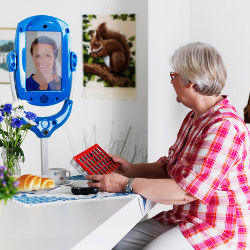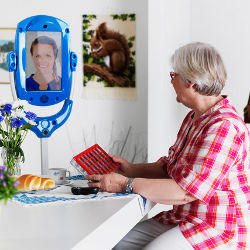
Just a few short years ago, it was extremely challenging for caregivers, friends, and relatives to check in on an elderly loved one without making a phone call or visiting them. Worse, the only dedicated technology products designed to help seniors were panic-button alert systems, which were usually only activated after something bad had occurred, such as a fall.
Technology is now being deployed that helps elderly people maintain their independence, while also providing peace of mind to loved ones who want to check in with them in a non-intrusive manner. Several companies have developed systems that use data fed from sensors located in the home to track seniors’ activity patterns, which can then be used to diagnose if something is out of the ordinary.
San Francisco-based Lively began shipping its eponymous sensor-based activity-tracking service in October 2013, and makes its products available in the U.S. and Australia. Its sensors are designed to be attached to various commonly used household items (such as refrigerator doors, toilet handles, pill boxes, or keychains), and are embedded with accelerometers to track motion. When motion occurs, the sensors send activity updates to an in-home data hub via Bluetooth, indicating an activity has occurred. The hub then uploads the data to compare daily events with normal routines and healthy preferences.
A dashboard, which can be viewed by family members via Internet browsers, tablets, and smartphones, will simply indicate a green smiley face next to each sensor to indicate an activity has occurred within an established normal time frame. If it has not, then an email or text message alert can be set up to spur someone to check in with their family member. The service has a onetime activation charge of $39.95, and then features a monthly service charge of $24.95.
Technology is now being deployed that helps elderly people maintain their independence, while also providing peace of mind to loved ones.
“It starts with a hub, and you plug it into the wall, and that’s literally the installation,” says Lively co-founder David Glickman. “We have an M2M data cellular connection, and that’s your network,” which is a boon for seniors that may not have a broadband Wi-Fi network in their home or an existing cellular account.
Davie, FL-based CarePredict is a service designed to provide peace of mind via a wearable sensor. CarePredict’s activity-tracking system uses line of sight technology to link room-identifying beacons to a wearable wristwatch-like band. A beacon is placed in each room in the house to provide location data, which allows greater correlation between an activity and its location (for example, cross-referencing an activity pattern of brushing teeth with a location of being in the living room could indicate an issue worth investigating.)
Sensor activity data is sent across a cellular connection to the cloud, where algorithms analyze it to compare real-time data to a baseline of normal behavior patterns (which are collected during the first seven days of tracking). If activity patterns change, an alert can be sent out to the user, the caregiver, or a loved one. However, the system is designed to only report anomalies from a normal pattern of behavior, and can be set up to mask information so it does not monitor or track specific activities.
As CarePredict founder and CEO Satish Movva points out, “Like my mom says, ‘you’re my son and I love you, but I don’t want you to know how many times I go to the bathroom.’ “
Because older adults wouldn’t accept being monitored by a video camera, Giraff Technologies AB, a Sweden-based technology company, has developed a two-way communications platform that allows greater interaction between the elderly and their families and caregivers as a viable and cost-effective option to enhance traditional care models.
The Giraff solution, which is described by founder Stephen Von Rump as an “avatar” (resisting the label of robot, since the device is unable to operate autonomously), is a mobile, physical embodiment of a person (via the Internet) in a remote location. Commercially available in Europe for the past four years, and designed to be operated remotely by a loved one or caregiver, it features a large screen that displays the operator’s face, and supports direct interaction with the elderly or invalid person. Giraff can establish a virtual ‘presence’ in a way that a static videoconferencing application (such as Skype) cannot, and does not support recording of any kind. Furthermore, unlike a robot, Giraff can only move if it is being controlled by a remote operator—it is unable to simply start up on its own.
A variety of wireless technologies can be used to transmit data signals to and from the avatar, including Wi-Fi and cellular networks, the latter allowing the robot’s use in homes where a person does not already have a Wi-Fi network set up. Beyond a simple communication tool, the Giraff is a platform that allows developers to leverage telehealth applications that can augment or replace the functions of a live, in-person home health aide visit. A remote operator can use Giraff to administer medication, check a person’s pulse, or visually inspect the person’s house for signs of potential issues, such as clutter that could contribute to a fall or indicate physical or cognitive decline.
More than 100 Giraff systems have been introduced successfully in Europe in care organizations and research groups. The devices were first introduced in 2010 on a trial basis in an eldercare day center in Sweden where caregivers that were known to the elderly residents were asked to operate the Giraffs. While there was definitely an initial shock to seeing the faces of the caregivers on the robot, Von Rump recalls, “very quickly, the Giraff faded into the background, and it just became a normal interaction between the resident and the caregiver.”
The Giraff “has a large display, so it can present a life-size image of a person’s head and shoulders,” Von Rump explains. “It’s human height, and has a very high-quality camera, because you need the wide angle of view to see a good quality image. The head can tilt up and down, and [the head] can [mimic] social gestures, such as moving side-to-side, which are very important.”
Perhaps the biggest driver of all of these solutions is the benefit of using technology to detect problems before they become emergency situations.
Furthermore, Von Rump notes that the Giraff’s ability to reduce its height to approximate the height of a person sitting down acts as an important social gesture that puts subjects at ease. “Part of this fear factor [with telepresence platforms] is the result of, the person is sitting or lying down, and now you have this human-height device towering over you,” he says.
Perhaps the biggest driver of all of these solutions is the financial benefit of using technology to detect problems before they become emergency situations. Giraff’s Von Rump notes that nursing home care can average in the neighborhood of $5,000 per month in the U.S., and his firm’s service is designed to stave off admittance to these facilities for as long as possible. “We have not established a price point yet, but we can certainly devise a service model where $5,000 is the cost for a year,” Von Rump says. Furthermore, the Giraff telehealth platform is also used to manage post-acute care to avoid the elderly “revolving door” of hospital readmissions. The average cost of a hospital stay for someone over 65 in the U.S. is $24,000; therefore, a single avoided readmission can pay for a virtual lifetime of the Giraff service.
Yet not all IT solutions for the elderly are focused strictly on the home environment. An IBM research team in Japan is focusing on ways to enable technology to support seniors’ declining cognitive abilities outside the home. IBM Fellow Chieko Asakawa is leveraging her team’s accessibility research (which revolves around finding solutions to make everyday tasks easier to accomplish for those with visual impairment) to adapt it to support the elderly, who often have impaired or declining abilities, making everyday tasks such as walking to the store or reading street signs more challenging to them.
“Our approach is based around cognitive assistance,” explains Asakawa. “When we look at sensors, GPS, data analytics, and image, object, and voice-recognition technologies, we found that we can augment human abilities or supplement missing abilities.”
The primary challenge being addressed by Asakawa’s team is taking the massive amounts of data generated by these various sensors, and then developing an intelligent assistant that can assist seniors, who are often unfamiliar with technology or even intimidated by it.
Asakawa notes that positioning technologies such as GPS are growing as reliable navigation support. However, for an elderly person, basic navigation is simply not fully usable to meet their needs, as it does not indicate important details, such as traffic flow, route impediments, or other potential obstructions. Asakawa’s team is working to adapt the location data and turn it into a useful, accessible tool for the elderly.
For example, if local government data showed a large number of elderly pedestrians fell down at a specific intersection, an application could take that data, cross-reference it with location data, and then via a voice alert, discreetly whisper to the elderly person, letting him or her know they were nearing that intersection, and providing directions rerouting them to a safer crossing point.
All told, the key to success for any technology product aimed at the elder market is to clearly illustrate why the product or service will help the elderly live more active lifestyles.
“We want senior citizens to understand the value of information technologies so they can use them in their daily lives to help them live more actively,” Asakawa notes.
The key to success for any technology product aimed at the elderly market is to clearly illustrate why the product or service will help the elderly live more actively.
Indeed, demonstrating value to the senior is at the heart of Lively’s LivelyGram photo service, according to Glickman. LivelyGram is a twice-monthly service through which Lively will automatically compile, publish, and mail to the elderly relative a personalized booklet of pictures uploaded by their family. Essentially, LivelyGram allows time-strapped family members to share their photos with an elderly loved one without having to take the time to create such a photo scrapbook themselves.
“[LivelyGram] is not the reason family members buy Lively,” Glickman admits, noting that elderly parents often also suffer from loneliness and isolation, and the photo-sharing service is “an experience that reminds the elders that Lively isn’t just about the daily activity sharing, but also about them getting something in return.”
Further Reading
Bruce, C.R.
Informed Decision Making for In-home Use of Motion Sensor-based Monitoring Technologies, The Gerontologist, http://bit.ly/1x75AQu
Will Activity Sensors in the Home Help Mom?, Geritech, http://bit.ly/1pMwA1V
Nonna Lea and a robot called Mr. Robin, DigitalAgendaEU, http://bit.ly/1vDpzXQ
Science Nation – Home sensors enable seniors to live independently, National Science Foundation, http://bit.ly/1oH0SDO






Join the Discussion (0)
Become a Member or Sign In to Post a Comment